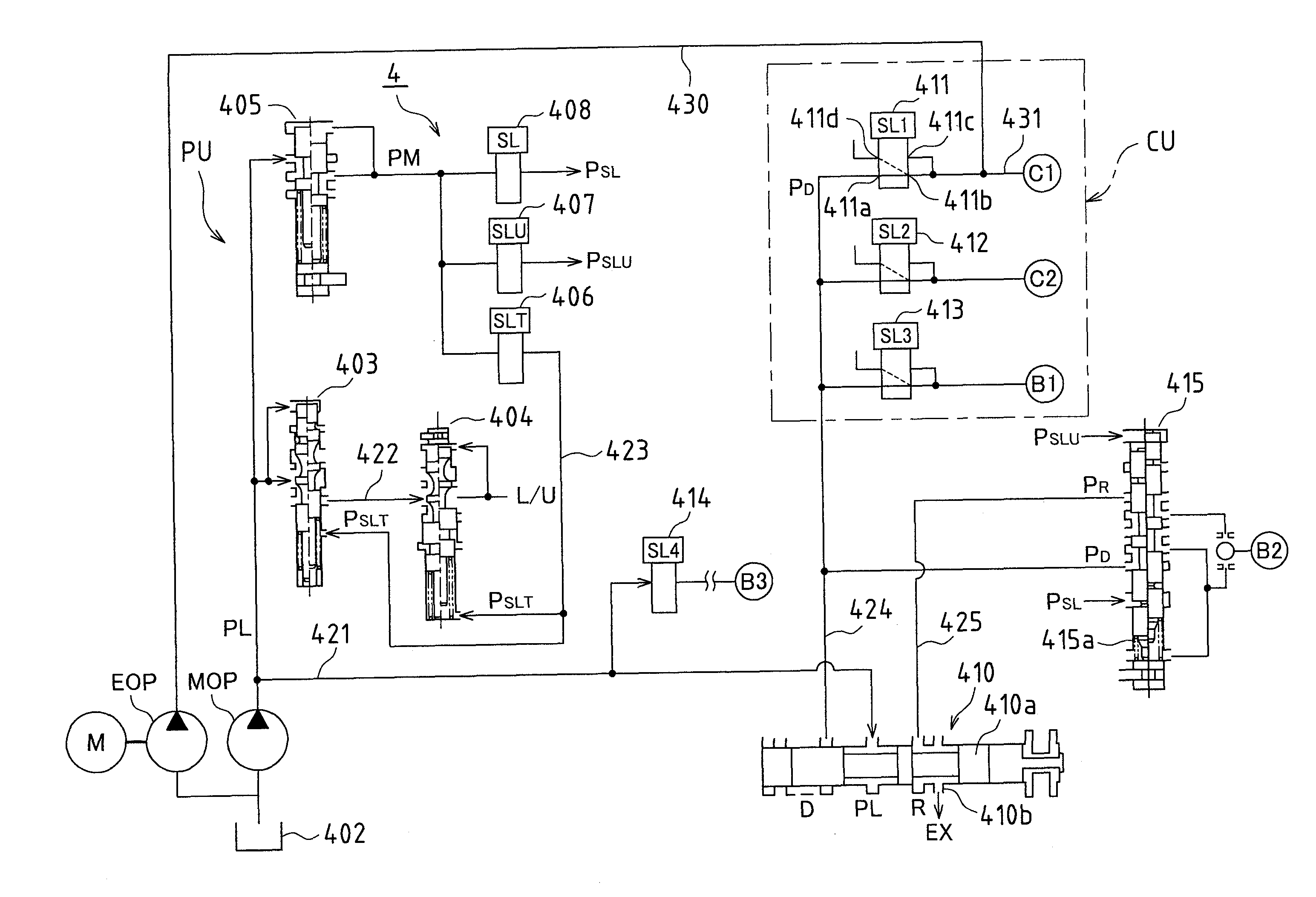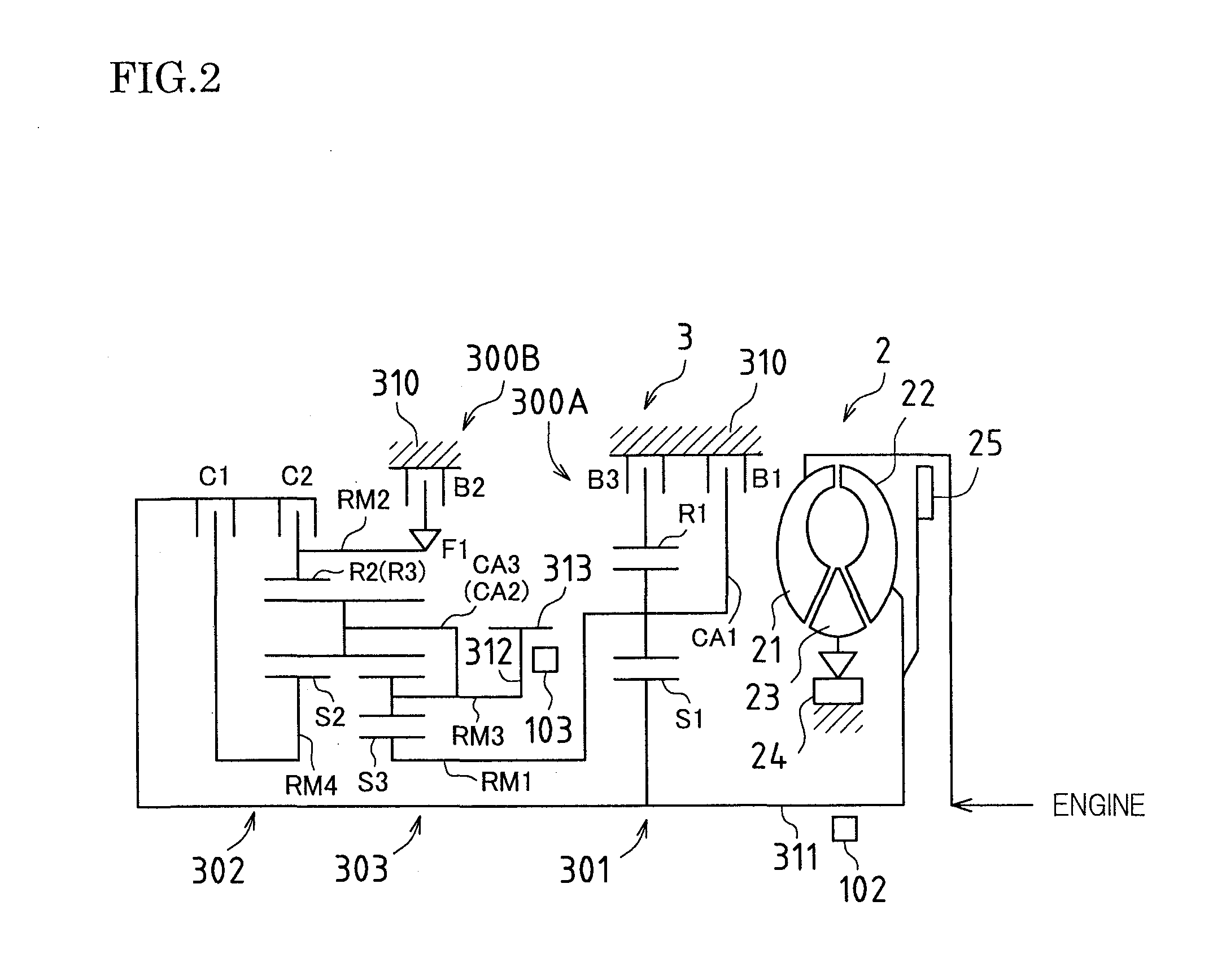Hydraulic pressure supply control apparatus for automobile
a technology of hydraulic pressure supply and control apparatus, which is applied in the direction of machines/engines, engine starters, transportation and packaging, etc., can solve the problems of fuel waste in this state, and achieve the effect of avoiding the elevation of cost and increasing the complexity of configuration
- Summary
- Abstract
- Description
- Claims
- Application Information
AI Technical Summary
Benefits of technology
Problems solved by technology
Method used
Image
Examples
embodiment 1
[0041]FIG. 1 is a schematic configuration diagram of a vehicle according to the present embodiment. The vehicle is an FF (front-engine, front-drive) type of vehicle, and mounted therein are an engine (internal combustion engine) 1 that is a running power source, a torque converter 2, an automatic transmission 3, a shift-by-wire system shift switching apparatus 5 that switches the shift range of the automatic transmission 3, a differential gear apparatus 6, an ECU 100, and the like.
[0042]A crankshaft (not shown) that is the output shaft of the engine 1 is coupled to the torque converter 2, and the output of the engine 1 is transmitted from the torque converter 2 to the differential gear apparatus 6 via the automatic transmission 3 and the like, and distributed to left and right drive wheels 7.
[0043]The following describes portions in the engine 1, the torque converter 2, the automatic transmission 3, the shift switching apparatus 5, and the ECU 100.
[0044]—Engine—
[0045]The engine 1 is...
embodiment 2
[0142]Next is a description of Embodiment 2. The present embodiment is a case in which a duty solenoid has been applied in place of the linear solenoid (SL1) 411. Other configurations and control are similar to those of Embodiment 1 described above, and therefore the following describes only differences from Embodiment 1.
[0143]FIG. 8 is a circuit configuration diagram showing part of a hydraulic pressure control circuit in the present embodiment.
[0144]As shown in FIG. 8, the configuration is such that a first hydraulic pressure PC1 for controlling the engagement state of the first clutch C1 is adjusted by a duty solenoid 416.
[0145]The duty solenoid 416 is configured by a three-way solenoid valve. Specifically, the duty solenoid 416 includes an input port 416a, an output port 416b, and a drain port 416c, and is capable of switching between a state in which the input port 416a and the output port 416b are in communication, and furthermore the drain port 416c is closed (the switching s...
embodiment 3
[0153]Next is a description of Embodiment 3. In the present embodiment, the manual shift valve 410 is used in order to prevent hydraulic oil supplied from the electrical oil pump EOP via the shunt hydraulic pressure supply passage 430 in the idle reduction state from flowing into the hydraulic pressure control unit PU. Other configurations and control are similar to those of Embodiment 1 described above, and therefore the following describes only differences from Embodiment 1.
[0154]The hydraulic pressure control circuit 4 of the automatic transmission 3 in the present embodiment is substantially the same as the one in Embodiment 1 described above (the one shown in FIG. 4).
[0155]In the present embodiment, when the idle reduction state described above has been entered, the spool valve 410a of the manual shift valve 410 is forcibly switched to the R range position. Accordingly, a D port connecting to the D range pressure oil passage 424 is closed, and the D range pressure oil passage 4...
PUM
 Login to View More
Login to View More Abstract
Description
Claims
Application Information
 Login to View More
Login to View More - R&D
- Intellectual Property
- Life Sciences
- Materials
- Tech Scout
- Unparalleled Data Quality
- Higher Quality Content
- 60% Fewer Hallucinations
Browse by: Latest US Patents, China's latest patents, Technical Efficacy Thesaurus, Application Domain, Technology Topic, Popular Technical Reports.
© 2025 PatSnap. All rights reserved.Legal|Privacy policy|Modern Slavery Act Transparency Statement|Sitemap|About US| Contact US: help@patsnap.com



